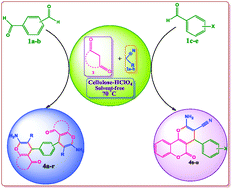Perchloric acid modified-cellulose: a versatile, novel and biodegradable heterogeneous solid acid catalyst for single-pot synthesis of novel bis-pyran annulated heterocyclic scaffolds under solvent-free conditions†
Abstract
A one-pot multi-component, green, and highly efficient protocol has been developed for the synthesis of novel bis-pyran annulated heterocyclic scaffolds (4a–r) using cellulose–perchloric acid (CPA) as an eco-friendly, biodegradable and recyclable catalyst in excellent yields under solvent-free conditions. Other remarkable features of this environmentally benign protocol are short reaction time, a wide range of functional group tolerance, use of inexpensive heterogeneous catalyst, and high yield of products via a simple experimental and work-up procedure as compared to the conventional methods. The cellulose–HClO4 (CPA) catalyst is characterized by using FTIR, powder XRD and SEM–EDX analyses. The stability of the catalyst was evaluated by TG/DTA characterization techniques. The catalyst can be recycled several times with a slight loss of its catalytic activity.


 Please wait while we load your content...
Please wait while we load your content...